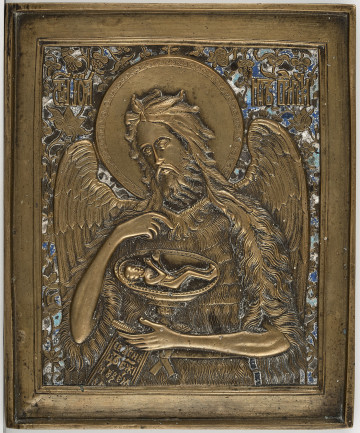
St. John the Baptist
20th century
Castle Museum in Łańcut
Part of the collection: Icons
Alexander Nevsky (1220-1263) was the prince of Veliky Novgorod and Pskov, Prince of Kiev, and Grand Prince of Vladimir. He came from the Rurik dynasty; he was the son of Yaroslav II and the grandson of Vsevolod III the Big Nest. In the history of Rus and Russia, he is celebrated as a competent diplomat, skilfully dealing with the Golden Horde and an invincible leader, defender of orthodoxy and the progenitor of Moscow's princely dynasty. Alexander Nevsky never lost a battle, although European historians are not inclined to exaggerate the political and strategic importance of his victories; they accuse him of excessive deference to the Golden Horde. Alexander owes the sobriquet 'Nevsky' to his victory over the Swedes in the Battle of Neva in 1240. Towards the end of his life, soon after taking monastic vows and being given the religious name of Alexis in 1263, Alexander died and was buried in Vladimir upon Klyazma. Recognised as a defender of Rus and orthodoxy, Alexander Nevsky was canonized at the 1547 ecumenical council as a saint of the Russian Orthodox Church. In 1724, his relics were transported to St. Petersburg and placed in the Alexander Nevsky Lavra. In old-time icons, Alexander Nevsky was portrayed as a knightly commander or a monk wearing a black Eastern Christian koukoulion. Since the transfer of the relics to St. Petersburg, Tsar Peter I forbade the creation of icons of the saint in monastic attire, therefore, after 1724, Alexander Nevski only appears in monastic robes on the icons of the Old Ritualists, who rejected church reforms, as can be seen in the presented painting. The feast of St. Alexander Nevsky is celebrated several times a year, including to commemorate his death in Vladimir on the 23rd of November and the transfer of his relics to St. Petersburg on the 30th of August (December 6 and September 12, respectively, in the Julian calendar).
Dimensions
height: 21 cm, width: 18 cm
Object type
Icons
Technique
gilding, tempera
Material
silver, tempera, wood
Origin / acquisition method
decyzja administracyjna
Creation time / dating
Owner
Castle Museum in Łańcut
Identification number
Location / status

20th century
Castle Museum in Łańcut

19th (?) century
Castle Museum in Łańcut

1800 — 1850
Castle Museum in Łańcut
DISCOVER this TOPIC
Museum of King Jan III's Palace at Wilanów
DISCOVER this PATH
Educational path